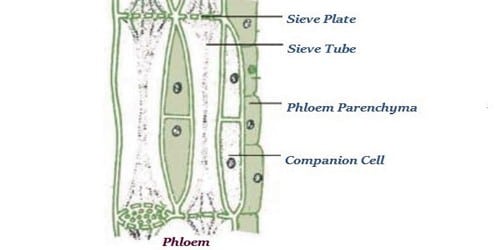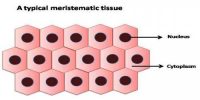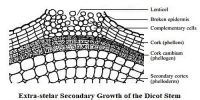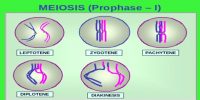Phloem tissue: The kind of tissue, made of some living and dead cells which have the chief function to conduct prepared food materials from leaf to different parts of the plant body is called phloem tissue. It is the complex tissue, which acts as a transport system for soluble organic compounds within vascular plants.
The phloem tissue consists of the following four elements
(1) Sieve tubes
(2) Companion cells
(3) Phloem parenchyma and
(4) Phloem sclerenchyma.
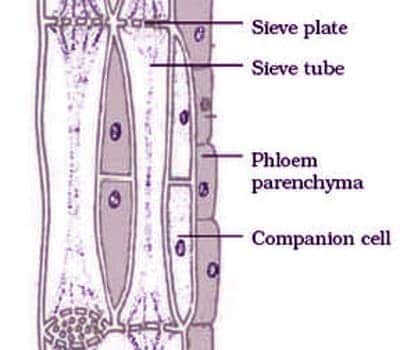
Sieve tubes:
- These are elongated cells with thin cellulose walls placed end to end which combinedly form a tube.
- The partition walls between the tubes are perforated and are known as sieve plates. They have no nuclei and reduced numbers of organelles to maximize space for the translocation of materials.
- When matured, the cells have lignified walls, a thin layer of protoplasm at the periphery and no nucleus.
- The sieve elements also have thick and rigid cell walls to withstand the hydrostatic pressures which facilitate flow.
Companion cells:
- The living elongated and narrow cells that lie adjacent to sieve tubes are known as companion cells.
- Their cell walls are thin and porous. They make a connection with the sieve tubes through the pores.
- They have a dense cytoplasm and a large nucleus. They have many mitochondria to fuel the active transport of materials between the sieve tube and the source or sink
- Contain appropriate transport proteins within the plasma membrane to move materials into or out of the sieve tube
Phloem parenchyma:
- They are the simple parenchyma cells present in phloem tissue.
- They are living cells in which the cell walls are thick and composed of cellulose. They have dense cytoplasm and a large nucleus.
- They are located near the finest branches and terminations of sieve tubes in leaf veinlets.
- They are called transfer cells, their main function in the transport of foods.
Phloem sclerenchyma:
- The sclerenchyma fiber that is present in phloem tissue is called phloem sclerenchyma. It is also known as blast fiber.
- These cells are dead but they are very long. Example- Jute fibers.
- Phloem fibers arise during secondary growth. The sclerenchyma cells in the phloem of many vascular plants, and is responsible for providing mechanical support to plants.
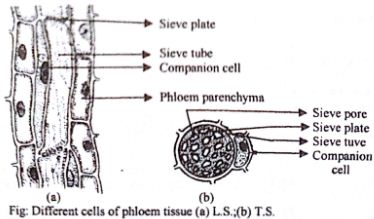
Function of Phloem
- Phloem is the vascular tissue in charge of transport and distribution of the organic nutrients.
- From the leaves where they are produced by photosynthesis to the rest of the plant.
- The sugars are moved from the source, usually the leaves, to the phloem through active transport.
- Water is drawn passively from the adjacent xylem over the gradient to create a sugar solution.
